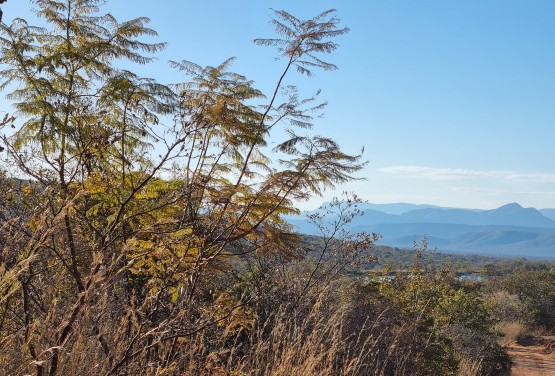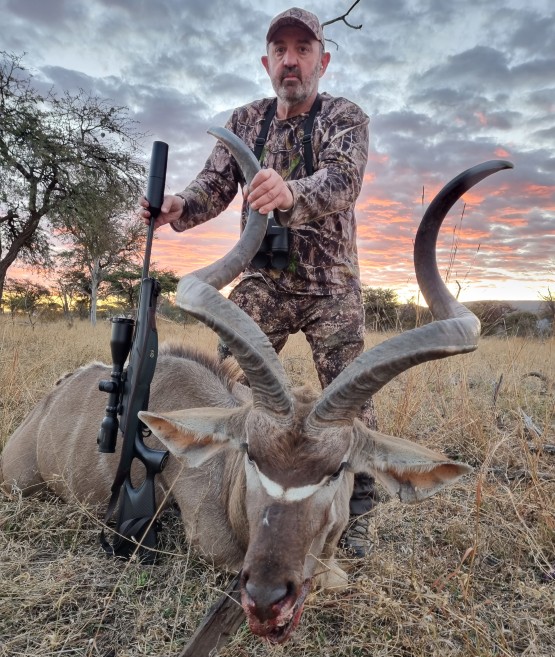Peter Osborne leaves the UK Roe rut behind in search of the 'Grey Ghost'.
During the long summer days and early starts, my mind, unlike most Capreolus Members, transfers from thinking about summer stalking and the impending Roe Rut, to that of stalking, or ‘hunting’ as it is better known, in Southern Africa for some genuine R&R in the African bush. To be honest there is no better place to be!

The best time to hunt in South Africa is in the winter months, from May through August and I personally like to be there from mid-June through July, as sometimes May can still be too warm and too wet with the grass and bush tall, thick, and unforgiving. I go annually and last year I spent a few weeks in the Limpopo region of South Africa, an area known for its incredible beauty, game farms and a plethora of plains game. Before booking my trip, I had decided that this was the year to successfully hunt my first Kudu Bull, a species that had evaded me and many other more capable hunters since first venturing out into the African bush. Kudu are known locally as the “grey ghost” given that they are so alert and thus elusive, with an ability to melt into the bush in an instant, never to be seen again.
However back to the real story….
With my lungs heaving in the thin cold highveld air, I had this recurring idea to reassess my training regime or more accurately lack thereof and with that thought, I recalled the quietness and ease of just sitting in a high-chair - a stalking approach that seems to exist on most shooting grounds and areas in England. I turned to see the bakkie (pickup truck) small and insignificant far below where we had disembarked a mere 30 minutes earlier, well before sunrise on this sub-zero morning. I imagined, despite seemingly wandering around a random hill in this vast Limpopo region that this was what it must feel like to climb a Munro, whilst stalking for a Red Stag in Scotland.
I raised my binoculars to glass the surrounding ground and see if there was any movement or changes to potentially indicate the presence of any game, but mostly it was a short diversion to extend the short break in the ascent, take in the spectacular view, recover my breathe and ensure my heartrate was less than 130. Critical elements to ensure I was positioned to take a safe shot should the situation arise. The sun was slowly appearing and painting dappled colours on the slopes and at that moment the trees and grasslands seemed in perfect harmony.
I allowed my thoughts to drift back to the basis for this and many other hunts, or stalks and watching the Deer Hunter in the late 70’s, specifically the scene where Robert de Niro using a Remington M700 is in the mountains of Pennsylvania alone with his thoughts, pitting his skills against a weary adversary – I must confess to having tried to replicate that feeling whist out hunting. However, I digress, my primary focus was to hunt the noblest of plains game – the Greater Kudu, an animal that had evaded me over many hunts and years. The name of the animal was imported into English in the 18th century from Xhosa ighude via Afrikaans to koedoe and thus kudu.

Although I was walking with a young tracker from the game farm, I was at the farm hunting with a very good friend who had hunted most of his life and had even passed the stringent Professional Hunter qualification and although his quest was simpler than mine, namely, to bag an Eland for the larder and to make biltong and droe wors, I had bigger things on my mind, that first kudu!
We continued the climb and as we were at an altitude of over 5000 feet above sea level, I was now insisting on a stop every few minutes to catch my breath and just take in the stunning scenery.
We sighted a small herd of Impala on the kopje (small hill), my tracker ranged them at 380m (too far for a realistic safe shot) and there was no backdrop, but it was such a thrill to just observe how they interact and move so effortlessly across the rocky, bushy terrain. After this brief interlude, we rounded several thorn trees and my tracker stopped and signalled he had seen something sizeable nearby. I took out my thermal and was able to discern the shape of a large antelope through the bushes.
We crept slowly, keeping low, round some thornbushes and across some rock fields and skirted a few small trees and using the binoculars watched as an Eland moved slowly out of cover to graze on an area of flattish grass and rocks at about 240m range – the buck was completely unaware of our presence. We moved slowly forward and with the wind in our favour, I had to answer the important question, do I shoot an Eland and hope my friend does not? As he did not have the freezer space for two and I had not heard another shot. I decided to risk it and tell him about the good news on the radio. We crossed another stony area (klipbank in Afrikaans), which proliferate the African landscape, the bush and grassland were getting sparser and with it, the cover, and the Eland was now only 180m away. I decided it was now or never!
We setup the sticks and I mounted my Sauer 404 with a Swarovski Z8i 2.3–18x56 P scope set to an 8 magnification (same as a bino’s). The gun was loaded with Hornaby .308 SST 150gr ammunition – which is ideal for flat shooting and is deadly accurate and an ideal round for African plains game.
I was confident having created a tight group whilst shooting at 300m at the Bisley range prior to heading to South Africa.
I set the turret to 200m, placed the crosshairs in the heart-lung region, released the safety-catch, took a depth breath, and slowly exhaled and squeezed the trigger. I heard the shot strike, and the Eland took off at pace and then after 50-60m it slowed, stopped, and then gracefully toppled over.
After the adrenaline had died down, I radioed my friend and he took an Eland off his wish list, however, the Kudu remained on mine. We returned to camp and supported the staff to unload this majestic and mighty animal and then after hearty brunch and a quick nap we set off again to continue the adventure. The Eland is the largest of all the African antelope with a large bull weighing as much as 1000kg (or 2,200lbs for those who still dream of the empire) and in many instances larger than a Cape Buffalo.
That afternoon we continued the search and despite seeing Impala, Zebra, Wildebeest, and a Hartebeest or two, the Kudu continued to elude me! The next morning, I set off well before sunrise and after two hours of tough tracking and walking, we came across a Warthog ambling along a dried waterbed, and after settling on the sticks, I took the shot at 160m and despite a clean strike it took us over 40 minutes to find the animal as there was no blood trail as they are incredible hardy.
As it was now well past 9am, we decided to head back to the vehicles which were a few kilometres away. Although we had stopped actively hunting, you always remain vigilant in the bush, and it was this vigilance that secured me my first Kudu. As with most days in Southern Africa, despite the initial cold, the temperature was slowly climbing, and I decided to do a final scan with the thermal before switching it off - this scan registered a large heat source in the distance. The pulse immediately started racing and I raised the binoculars and after a small period, the kudu moved out from behind some cover grazing nonchalantly seemingly completely unaware of our presence.
We estimated the bull was just over 300m away and then we slowly edged closer, using the cover and wind to our advantage. After, what seemed like an age, we had closed the gap to 180m and I setup the sticks, set the turret to 180m, did a final wind check, and then settled in to wait for the animal to turn side-on to allow a shot.
This was the culmination of many hunts and adventures, to say that it was a key period in my hunting journey, would be to underplay the moment. I still regularly replay the hunt, the sequence of events, the setup, and the shot in my mind and at the end of this dreaming, I am always left with a smile – what a day and what a beautiful animal.
Although only having one and a half spiral, because of the amazing width the horns were over 52” in length and within a whisker of the 53 7/8 minimum to be classified as a Rowland Ward.
Now as I start to plan my next trip, I imagine what this will bring!
The Capreolus Club has contacts with some leading providers of hunting in South Africa, just another good reason to become a member. If you’d like to apply for membership of this thriving and friendly club, you can do so here: capreolusclub.co.uk/apply-now



















